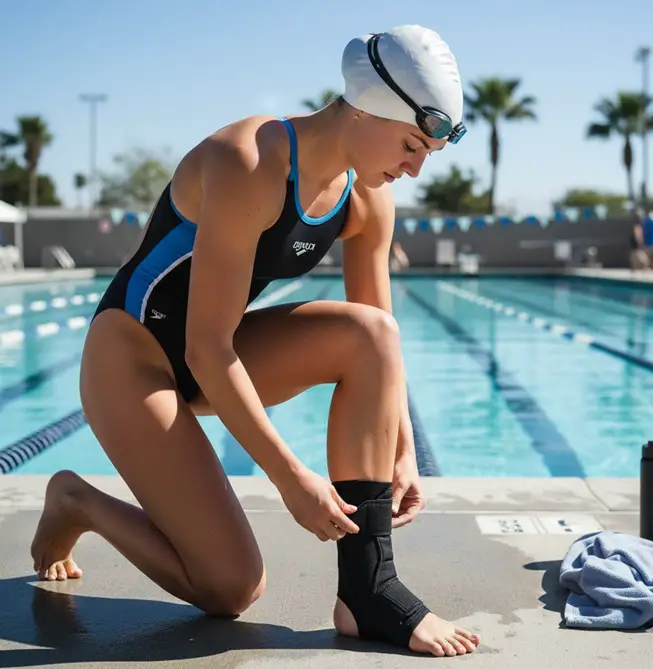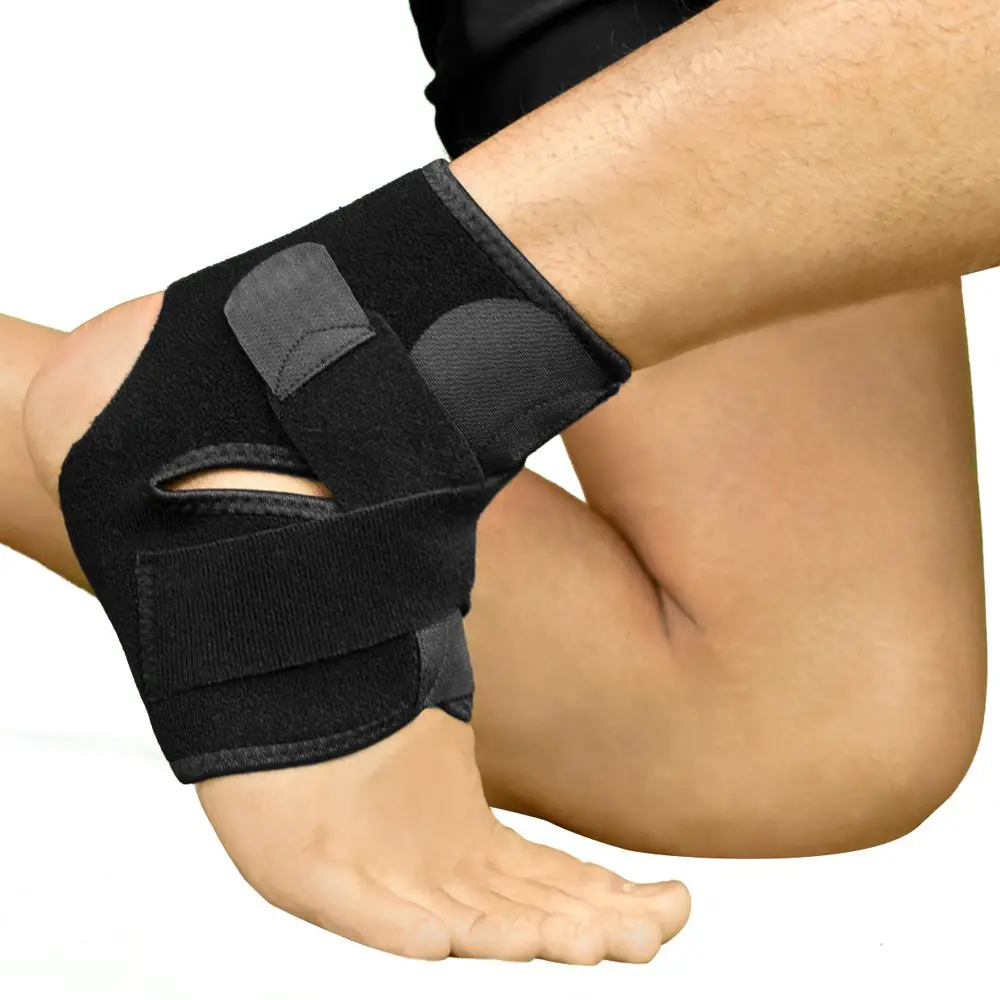
Swimming is one of the best full-body workouts you can do to increase your strength, stamina, and overall well-being.
Like any physical activity, swimming and surfing can cause injuries or exacerbate existing ones.
Learning what to expect in terms of an injury and what to expect in terms of how to deal with the injury will get you back in the pool faster and keep you on your tight training schedule.
Be sure to listen to your body, stop when it needs to spot, and if something feels like it has popped or pulled, don’t be a hero.
Get out of the pool and do a system check on yourself and only jump back into your workout if you are comfortable doing so.
As always, check with your primary care physician to see if you are healthy enough to start using swimming as aerobic exercise.
If you are injured, check with your trainer or rehabilitation specialist before adding swimming to your recovery.
Causes of Ankle Pain after Swimming
While many of the injuries typical of swimming and surfing are found in the upper body, ankle pain from swimming is quite common as a lower-body injury.
The main root of ankle pain from swimming is the failure of the swimmer to relax the foot as it re-enters the water during their strokes.
An ankle joint held tightly slapped against the water in repetition throughout a workout will lead to increased pain.
It can lead to pain, but the more often you hold your foot tight throughout your stroke, the higher the likelihood is that you can hit your foot wrong, which could lead to a sprain.
This is no different than landing awkwardly in basketball or hitting the base awkwardly in baseball.
For more advanced training, when you flip and go to kick off the wall, it is possible that you hit your foot awkwardly or rolled it underwater as you went to turn and push off the edge of the pool and begin your return back down the pool.
Continuing once you hear a pop or feel pain along your ankle is not a sign of good training but a sign of ignoring one’s own needs.
3 Best Waterproof Ankle Brace for Swimming
Wearing an ankle brace for water sports like swimming, surfing, diving, and others can help your feet stay protected.
However, picking the right one that delivers maximum benefits can often be tough for athletes.
For your help, we have reviewed some of the best options available on Amazon. These are completely waterproof and are specifically designed for sporting in the water.
1- BraceAbility Neoprene Water-Resistant Ankle Brace

Neoprene Water-Resistant Ankle Brace by BraceAbility is best for swimmers, surfers, and divers.
Athletes who are into other water sports like water polo, scuba diving, wakeboarding, bodyboarding, windsurfing, skiing, sailing, rowing, etc. can also use this waterproofed ankle brace for guarding their feet.
The soft ankle wrap by BraceAbility is innovatively designed and is clinically proven to offer greater athletic support and protection from conditions like an ankle sprain, strains, swelling, instability, tendonitis, post-fracture recovery, etc.
The brace comes with 3/16” thick premium-grade neoprene material to offer you better compression and targeted heat retention. This also helps in improving the circulation around your sore ankle.
Also, its flexible figure-eight straps are highly adjustable to provide you with optimal support when you are in the water.
This water-resistant ankle brace is not only good for athletes but also for non-athletes.
No matter whether you spend most of your time sporting or just walking and running, you can use it for your daily activities for maximum ankle protection from swelling or pain.
2- Nvorliy AquaFlex Pro Compression Ankle Sleeve

If your ankles have ever begged for mercy after a long surf session, an intense swim, or a paddle workout, the Nvorliy AquaFlex Pro Compression Ankle Sleeve is exactly what they’ve been waiting for.
Designed specifically for water athletes — swimmers, surfers, divers, kayakers, and weekend paddle-boarders — this sleek ankle support delivers the perfect balance of flexibility, protection, and confidence in motion.
Engineered with Dynamic Compression Technology, this Nvorliy AquaFlex ankle brace provides adaptive, elastic support that stabilizes your ankle without locking it down.
You stay agile, balanced, and pain-free, whether executing a sharp underwater turn or bracing against a strong current.
Made from premium hydro-resistant neoprene, it doesn’t sag, slip, or soak up water — instead, it stays snug and quick-drying through salt, chlorine, or fresh water alike.
Its anti-slip cuffs keep the sleeve firmly in place, so you can focus on your dive instead of readjusting gear. The ergonomic contour design fits like a second skin, moving seamlessly with your foot for full natural motion.
At just 30 grams, it feels featherlight yet supportive, while the breathable and warmth-regulating mesh zones keep your muscles comfortable in any temperature.
And with the brand’s 100% satisfaction promise, you’re covered — whether you need a different size or a refund, no questions asked.
In short, AquaFlex Pro isn’t just ankle protection — it’s your aquatic advantage. Slip it on, hit the water, and move like the waves themselves.
3- Adjustable Ankle Support Compression Brace for Surfing

This high-quality ankle support compression brace is ideal for acute injuries such as muscle strain, ligament sprain, twisted ankle, rolled ankle, or for stabilizing the weakened ankle joints post-surgery.
The beauty of this waterproof ankle support is its open-heel design. This allows a wide range of motion during your play activity while providing maximum support for the ankle tendons and joints.
This comfortable ankle brace features breathable neoprene material (for retaining heat and preventing skin irritation), which is flexible, washable, and highly durable.
The brace also comes with high-grip crisscross straps (for customized tightness and bracing) and is good for indoor as well as outdoor sporting.
The best thing is you can use this single brace for both feet – up to 28cm (11″) in feet arch circumference.
What are Common Swimming Injuries?
As a strenuous athletic activity, swimming can lead to some injuries due to overexertion and a lack of stretching, among other issues.
The most common injury is inflammation or irritation of the shoulder joint. In addition to the shoulder pain, you can see additional damage done to the rotator cuff regarding tendonitis or tears.
In some cases, tears can lead to surgery, and in almost all cases, a tear will immediately halt training.
Shoulder impingement syndrome is common in frequent swimmers as it pertains to the rotator cuff and damage to the muscles around the shoulder blade due to the overhead swimming motions of the standard swimming technique.
Tears in this cartilage can also be a common occurrence in those who use swimming and surfing sports as a staple of their workout routine.
Neck and lower back pain can also occur as a result of the strenuousness of the swimming workout, and this will be especially true if the athlete does not take the pre-workout stretch properly.
Most of the swimming motion is made through the feet and arm (through the bicep). Overuse can lead to the development of tendonitis in that area as well.
Without adequate rest, stretching, or supportive gear, these overused tendons can become sore, swollen, and less efficient — reducing performance and increasing the risk of injury.
That’s why using proper compression support sleeves and focusing on muscle recovery and technique correction is crucial to keep your movements powerful yet pain-free.
A few other body parts susceptible to injury due to swimming include the elbow, knee, hip, and ears. However, the injuries on these parts are less commonly seen.

Things to Check When Buying an Ankle Brace for Swimmers
If you’re a swimmer or surfer, your ankles are your power source — they propel, stabilize, and balance you through every stroke and turn.
But constant exposure to water, repetitive motion, and uneven force from waves can easily strain them.
That’s where a good ankle brace makes all the difference — offering support, injury prevention, and confidence to move freely.
However, not all braces are created equal, and choosing the wrong one can do more harm than good. Here’s what to look for before buying:
1. Water-Resistant Material
Your brace should be made from neoprene or a similar hydro-resistant material that won’t absorb water or lose elasticity when wet. This ensures consistent compression and durability, whether you’re in saltwater, chlorinated pools, or fresh water.
2. Compression and Support Balance
Look for adjustable compression levels that provide firm support without restricting mobility. A brace that’s too tight can limit your kicks, while one that’s too loose won’t prevent strain.
3. Anti-Slip Design
An effective ankle brace for aquatic use should have non-slip cuffs or grip bands to stay securely in place during intense activity — no one wants to pause mid-surf to readjust gear.
4. Lightweight and Breathable
To protect your ankles while in water, opt for a featherlight design (ideally under 50 grams) with mesh ventilation zones to maintain comfort and temperature regulation. This helps prevent stiffness in colder water.
5. Anatomical Fit
A good brace should contour naturally to your ankle, providing a “second-skin” feel. Ergonomic shaping reduces friction, allowing a full range of motion while keeping support consistent.
6. Easy Maintenance and Quick-Dry
Post-session cleanup matters. Choose an ankle guard or a brace that dries quickly, resists odor buildup, and retains its shape after multiple uses.

A Few Ankle Pain Prevention Tips for Swimmers and Surfers to Keep in Mind
Whether you’re gliding through waves or powering across a pool, your ankles work harder than you think.
A little care and the right habits can go a long way in keeping them strong, flexible, and pain-free.
1- Stretch before starting
The first way to help prevent ankle pain is to not neglect proper stretching before you begin exercising.
By stretching the ankle tendons and joints, you have warmed up the muscles and are not just jumping in the pool ice cold and putting a strain on already tight muscles.
2- Learn proper techniques
The next thing you can do is start studying proper technique or at least becoming more conscious of just how your foot is hitting the water on your stroke.
Just as you learned how to breathe during competitive surfing or swimming, you must now learn the proper technique when kicking the water at the conclusion of your stroke.
3- Keep yourself protected, and don’t hit.
When flipping and kicking off the other way, be sure to focus on hitting the wall square and pay attention to your surroundings so that you can hit the wall on a flat part.
Then, during your flip or roll, focus on properly tucking your feet so that they do not drag across the bottom of the pool or slap the top of the pool water with your feet tense instead of being properly relaxed so that they do not take on the repeated damage.
The conclusion
Swimming is a form of exercise that is very gentle on the muscles and ligaments. It aimed to make them as flexible as possible.
However, along with practicing and enjoying your swimming session every week, you need to guard your body parts like your ankle and feet, which are most vulnerable to getting an injury.
To get rid of all the stress and to enjoy your swimming session best, it’s good to invest in a high-quality swimming ankle brace rather than being sorry at the end of a bad day.




